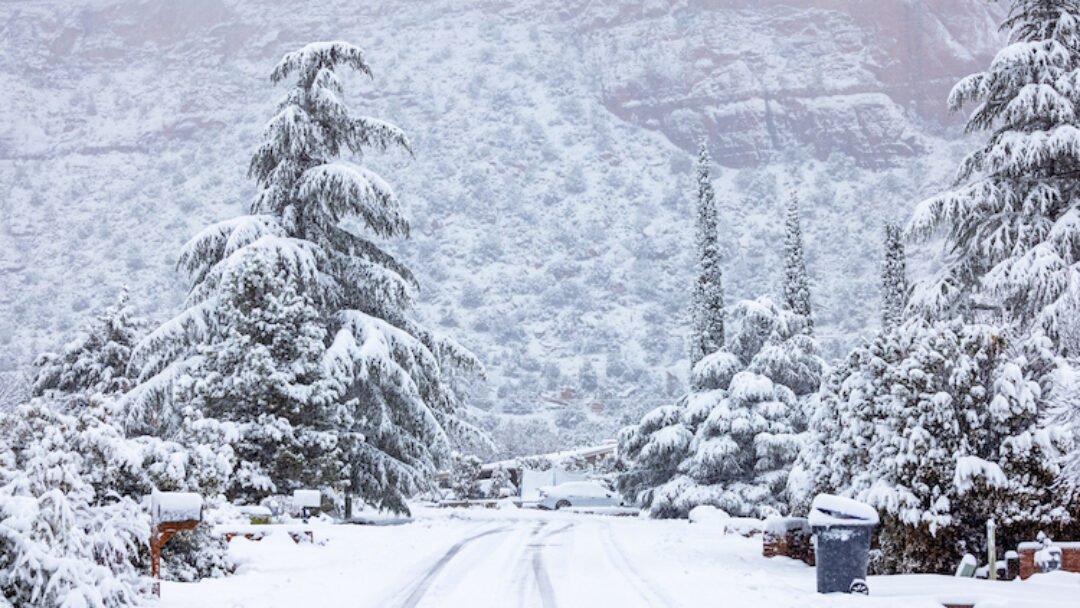Winter has finally come to Arizona. For all of our northern Arizona residents and those who plan to travel and spend time in snow, winter storms can be beautiful, but they can also be dangerous and disruptive. Understanding the nature of these storms and the risks they pose is essential for staying safe and prepared. Winter storms are characterized by heavy snowfall, strong winds, and freezing temperatures. They can cause power outages, road closures, and make it difficult to travel or even leave your home. One of the most significant risks associated with winter storms is hypothermia, which occurs when the body loses heat faster than it can produce it. Knowing the signs of hypothermia and other winter-related health risks is crucial for staying safe.
To stay informed about winter storms and their potential risks, it’s important to monitor weather forecasts and alerts. Pay attention to warnings from local authorities and take them seriously. Keep an emergency kit stocked with essential supplies such as food, water, and warm clothing. It’s also crucial to have a plan in place for communication and evacuation if necessary. By understanding the risks associated with winter storms and staying informed, you can better prepare yourself for the challenges they may bring.
Preparing for a Winter Storm
Being prepared is the key to staying safe during a winter storm. Start by creating a winter storm emergency kit that includes essential supplies. This kit should include non-perishable food items, bottled water, a flashlight, batteries, a first aid kit, extra medications, a battery-powered radio, and extra blankets or sleeping bags. It’s also important to have a backup power source, such as a generator or portable battery pack, in case of power outages.
In addition to your emergency kit, make sure your home is properly insulated and prepared for the cold weather. Insulate windows and doors with weatherstripping or plastic sheeting to prevent drafts. Keep your home well-heated by maintaining your heating system and having it serviced regularly. It’s also a good idea to have a supply of firewood or an alternative source of heat, such as a propane heater or kerosene heater, in case of power outages.
Lastly, make a plan for communication and evacuation. Have a designated meeting place for your family members in case you are separated during the storm. Share your plan with neighbors or friends, so they know where to find you in case of an emergency. Being prepared and having a plan in place will help you stay calm and focused during a winter storm.
Essential Supplies for Winter Storm Survival
When a winter storm hits, it’s essential to have the right supplies on hand to ensure your survival and comfort. Here are some essential items to include in your winter storm emergency kit:
- Non-perishable food: Stock up on canned goods, granola bars, and other non-perishable food items that can be easily prepared without electricity.
- Bottled water: Have at least one gallon of water per person per day for drinking and sanitation purposes.
- Flashlight and batteries: Ensure you have a reliable source of light in case of power outages.
- First aid kit: Include bandages, antiseptic ointment, and any necessary medications.
- Extra blankets or sleeping bags: Stay warm and comfortable even if the power goes out.
- Battery-powered radio: Stay informed about the latest weather updates and emergency instructions.
- Extra medications: If you take any prescription medications, make sure you have a supply that will last you through the storm.
- Hand warmers and extra gloves: Keep your hands warm and protected from the cold.
Having these essential supplies on hand will help you stay comfortable and safe during a winter storm.
Winter Driving Tips to Stay Safe on the Road
Driving in snowy conditions can be treacherous, but with the right preparation and precautions, you can reduce the risk of accidents and stay safe on the road. Here are some winter driving tips to keep in mind:
- Prepare your car: Before you hit the road, make sure your car is in good working condition. Check the tires, battery, brakes, and windshield wipers. Ensure your gas tank is at least half full to prevent freezing.
- Slow down and maintain a safe distance: Reduce your speed and increase your following distance to allow for longer stopping distances on icy roads.
- Brake and accelerate gently: Avoid sudden movements that can cause your car to lose traction. Brake and accelerate gradually to maintain control.
- Use your headlights: Keep your headlights on, even during the day, to increase visibility to other drivers.
- Clear snow and ice from your car: Before driving, remove all snow and ice from your car’s windows, roof, and lights to maximize visibility.
- Know how to handle skids: If your car starts to skid, remain calm and steer in the direction you want to go. Avoid slamming on the brakes, as this can make the skid worse.
- Stay informed about road conditions: Check for road closures or advisories before you leave and adjust your route if necessary.
By following these winter driving tips, you can reduce the risk of accidents and ensure your safety on the road.
What to Do If You Get Stuck in the Snow
Even with the best preparation and precautions, there’s still a chance that you may get stuck in the snow during a winter storm. If this happens, it’s important to stay calm and take the following steps to get unstuck:
- Don’t spin your tires: If your car is stuck, avoid spinning your tires, as this can dig you deeper into the snow. Instead, try gently rocking your car back and forth to create momentum.
- Clear snow from around your tires: Use a shovel or any available tools to remove snow from around your tires and create a clear path for your car to move.
- Use traction aids: If your car is still stuck, try using traction aids such as sand, kitty litter, or traction mats to improve traction and help your car gain traction.
- Call for help: If all else fails, call for roadside assistance or emergency services. They have the equipment and expertise to help you get unstuck safely.
Remember, getting stuck in the snow can be frustrating, but it’s important to stay calm and take the necessary steps to get unstuck safely.
How to Keep Your Home Warm During a Winter Storm
Keeping your home warm during a winter storm is essential for your comfort and safety. Here are some tips to help you maintain a warm and cozy home:
- Insulate windows and doors: Use weatherstripping or plastic sheeting to seal any gaps and prevent drafts.
- Close curtains and blinds: Keep curtains and blinds closed to reduce heat loss through windows.
- Use draft stoppers: Place draft stoppers at the bottom of doors to prevent cold air from entering your home.
- Use space heaters wisely: If you’re using space heaters, make sure to follow safety guidelines and keep them at least three feet away from any flammable materials.
- Layer up: Wear warm clothing and use blankets to stay warm instead of relying solely on your heating system.
- Use the oven for warmth: If your power goes out, you can use your oven to provide some warmth. Just make sure to keep it closed and stay in the same room to prevent carbon monoxide buildup.
- Close off unused rooms: If there are rooms in your home that you don’t need to use during a winter storm, close the doors to prevent heat from escaping.
By following these tips, you can keep your home warm and comfortable during a winter storm.
Safety Precautions for Power Outages During Winter Storms
Power outages are common during winter storms, so it’s important to take safety precautions to protect yourself and your family. Here are some safety tips to keep in mind:
- Use generators safely: If you’re using a generator, make sure to follow the manufacturer’s instructions and place it outside, away from windows and doors. Never use a generator indoors, as it can produce deadly carbon monoxide gas.
- Avoid using candles: While candles may provide light during a power outage, they pose a fire hazard. Use battery-powered lights instead.
- Keep food safe: If your power is out for an extended period, keep your refrigerator and freezer doors closed as much as possible to maintain the cold temperature. Use perishable food items first and discard any that have been at room temperature for more than two hours.
- Avoid carbon monoxide poisoning: Never use gas-powered appliances, such as ovens or stoves, to heat your home. These can produce carbon monoxide, a deadly gas that is odorless and colorless.
- Stay warm: Layer clothing, use blankets, and consider using alternative heating sources such as a fireplace or wood-burning stove if they are properly vented.
- Stay informed: Listen to a battery-powered radio for updates on the power outage and any instructions from local authorities.
By following these safety precautions, you can protect yourself and your family during a power outage caused by a winter storm.
Winter Storm Emergency Services and Resources
During a winter storm, it’s essential to know where to turn for help and resources. Here are some emergency services and resources that can assist you during a winter storm:
- Local emergency services: Familiarize yourself with the contact information for your local police, fire department, and emergency medical services. In case of an emergency, call 911.
- Roadside assistance: If you get stuck in the snow or experience car trouble, contact your roadside assistance provider for help.
- Local shelters: If you need a warm place to stay during a winter storm, contact local shelters or emergency warming centers. They can provide temporary shelter and resources.
- Power companies: Report any power outages to your local power company. They can provide updates on the status of the outage and estimated restoration times.
- Community resources: Stay connected with your community through social media or community forums. They can provide valuable information and resources during a winter storm.
By familiarizing yourself with these emergency services and resources, you’ll be better prepared to handle a winter storm.
Staying Safe and Prepared for Winter Storms
Winter storms can be unpredictable and dangerous, but with the right preparation and precautions, you can stay safe and comfortable. Understanding the risks associated with winter storms, preparing an emergency kit, and knowing what to do if you get stuck in the snow are all essential steps to staying safe. Additionally, keeping your home warm, taking safety precautions during power outages, and utilizing winter storm survival hacks and tips can make a significant difference in your comfort and well-being.
Remember to stay informed about weather forecasts and alerts, and listen to the instructions of local authorities. By being prepared and taking the necessary precautions, you can navigate winter storms with confidence and ensure the safety of yourself and your loved ones. Stay warm, stay safe, and stay prepared.








